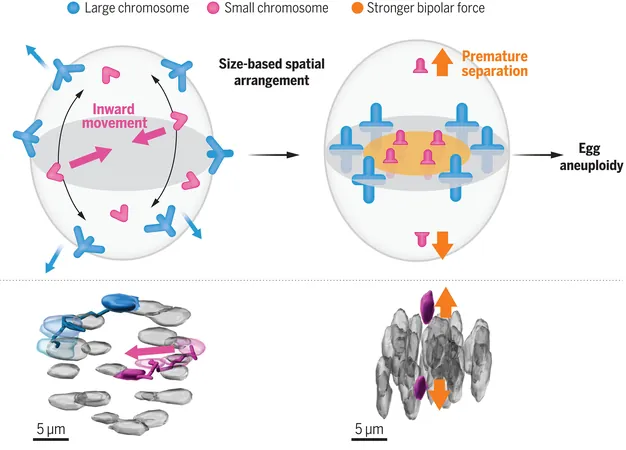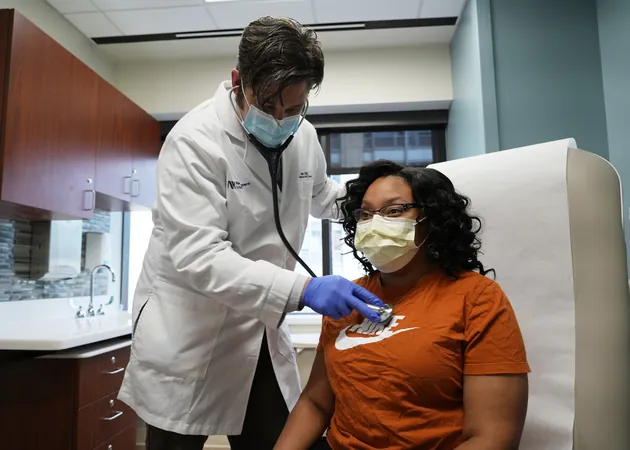
Are Smaller Chromosomes the Hidden Culprits Behind Egg Cell Division Errors? Scientists Investigate!
2024-10-10
Author: Nur
In a groundbreaking study, researchers at RIKEN have unveiled crucial insights into the cellular mechanisms responsible for chromosomal abnormalities, which often lead to miscarriages and congenital disorders like Down syndrome.
These abnormalities predominantly affect the sex cells—egg cells (oocytes) in women and sperm cells in men—resulting in improper division that either transfers an excess or a deficient number of chromosomes to embryos. Alarmingly, it is estimated that nearly a third of all miscarriages can be attributed to this issue.
The phenomenon typically occurs during the critical process of chromosome segregation, yet the exact mechanisms behind these errors remain enigmatic. As age increases, so does the risk of such errors, particularly among women. Tomoya Kitajima, a prominent researcher at the RIKEN Center for Biosystems Dynamics Research, has focused on understanding the connection between aging and chromosome segregation, especially as Japan and several other countries face declining birth rates. He states, “We should be able to have babies when we desire, but we lack the technology to overcome the problems of chromosome segregation errors.”
Back in 2015, Kitajima’s team identified the main culprit behind segregation errors: the premature splitting of certain chromosomes before a cell is fully prepared for division.
The latest research, published in the esteemed journal *Science*, investigates whether smaller chromosomes are particularly prone to premature separation and subsequent errors. The team conducted experiments on mice, isolating oocytes from their ovaries and injecting them with specialized RNA molecules designed to deliver fluorescent proteins to targeted chromosomes. Under advanced microscopy, these fluorescent proteins illuminated the chromosomes, allowing the researchers to observe them in action.
Remarkably, their statistical analysis revealed a striking pattern: smaller chromosomes tended to cluster near the core of the spindle—a fibrous structure that plays a crucial role in aligning chromosomes for division. Meanwhile, larger chromosomes surrounded them. The spindle generates push-and-pull forces essential for chromosome alignment, but these forces can lead to premature separation, particularly for smaller chromosomes.
The team also discovered that these binding forces tend to weaken in aging oocytes, making the smallest chromosomes even more susceptible to division errors.
Interestingly, the researchers noted that this phenomenon, where smaller chromosomes are encapsulated by larger ones, is not only limited to dividing cells; it can also be observed in non-dividing cells. Kitajima expressed surprise at this recurring formation, saying, “It came as quite a surprise.”
As scientists continue to delve deeper into these cellular mysteries, their findings could pave the way for significant advancements in reproductive technologies, potentially offering hope to individuals facing fertility challenges related to chromosomal abnormalities. Will this research revolutionize our understanding of egg cell division and transform reproductive health? Only time will tell! Stay tuned for more updates as this fascinating field evolves.



 Brasil (PT)
Brasil (PT)
 Canada (EN)
Canada (EN)
 Chile (ES)
Chile (ES)
 España (ES)
España (ES)
 France (FR)
France (FR)
 Hong Kong (EN)
Hong Kong (EN)
 Italia (IT)
Italia (IT)
 日本 (JA)
日本 (JA)
 Magyarország (HU)
Magyarország (HU)
 Norge (NO)
Norge (NO)
 Polska (PL)
Polska (PL)
 Schweiz (DE)
Schweiz (DE)
 Singapore (EN)
Singapore (EN)
 Sverige (SV)
Sverige (SV)
 Suomi (FI)
Suomi (FI)
 Türkiye (TR)
Türkiye (TR)